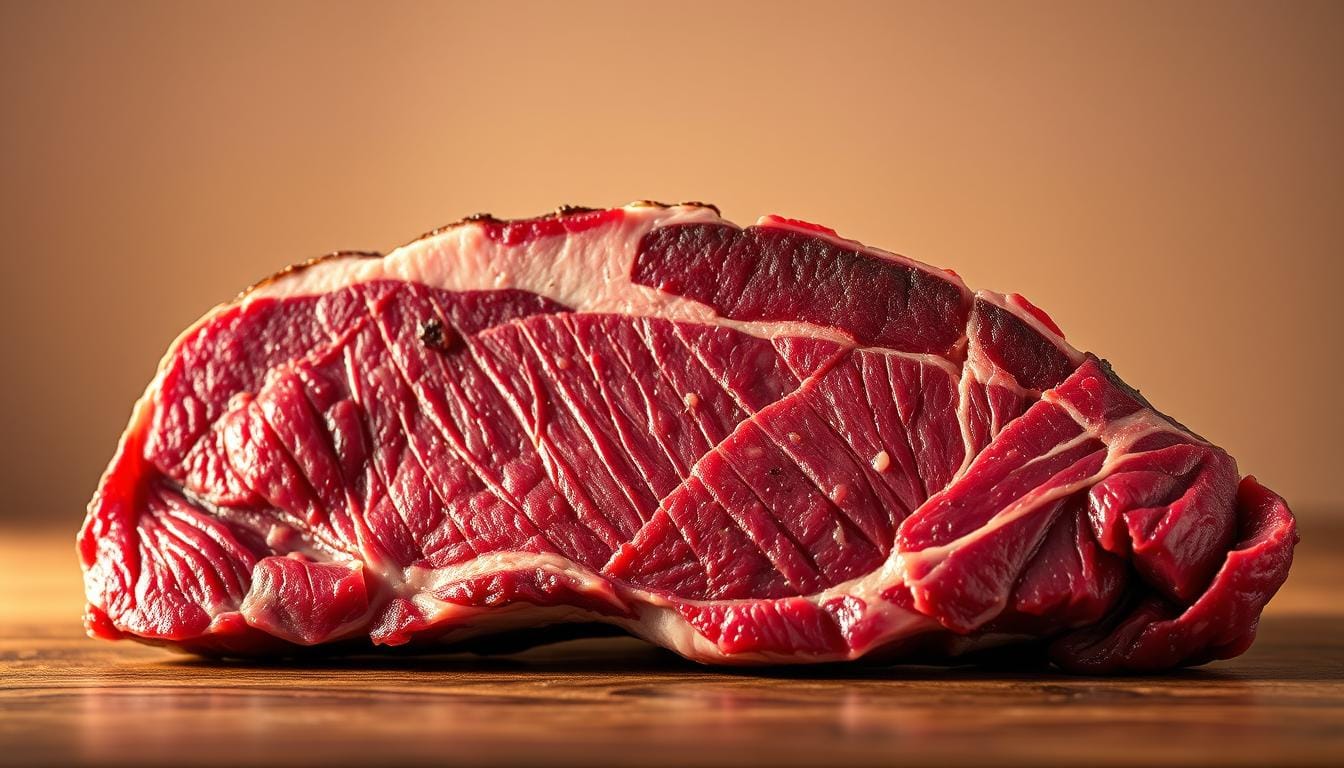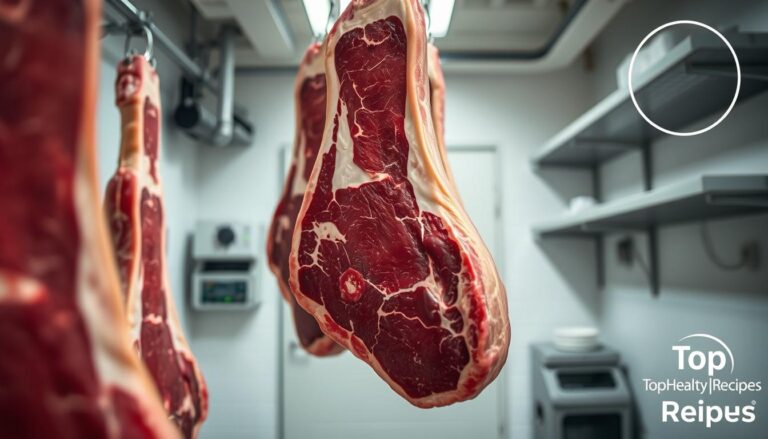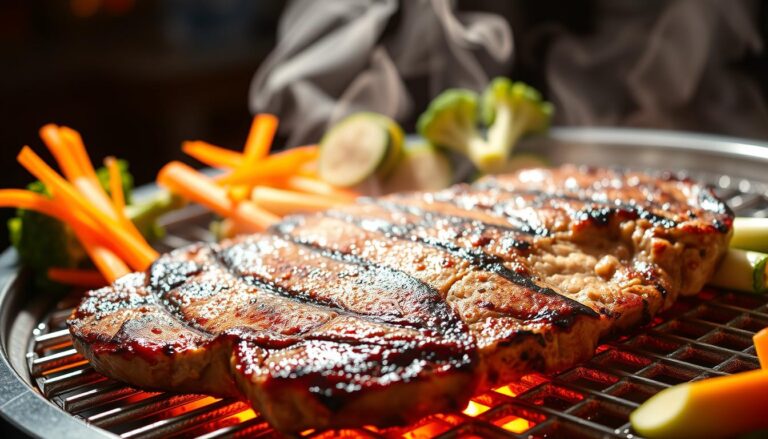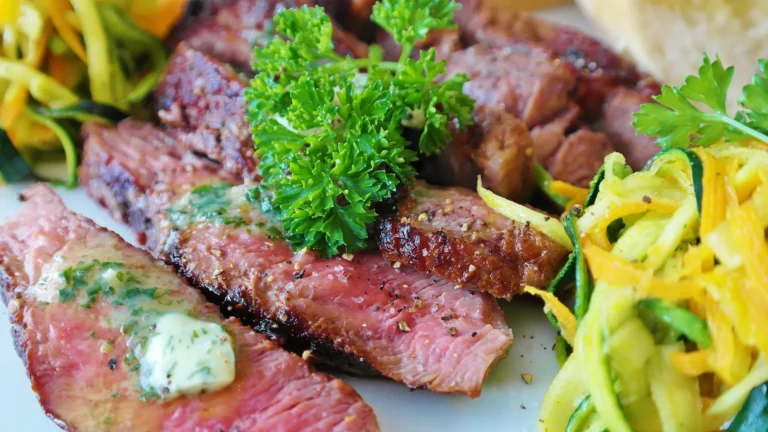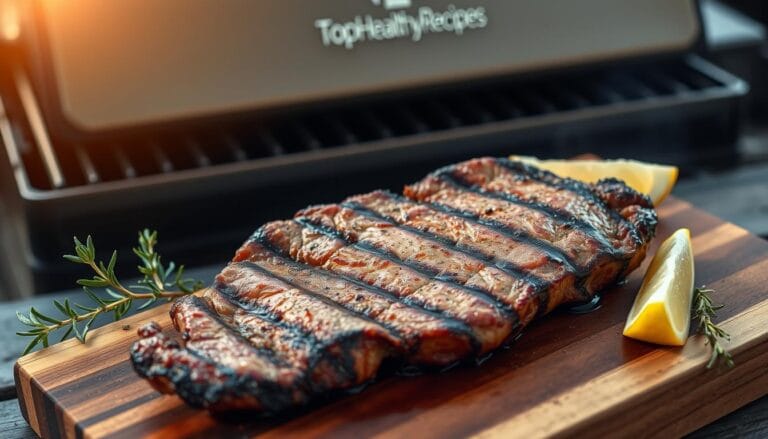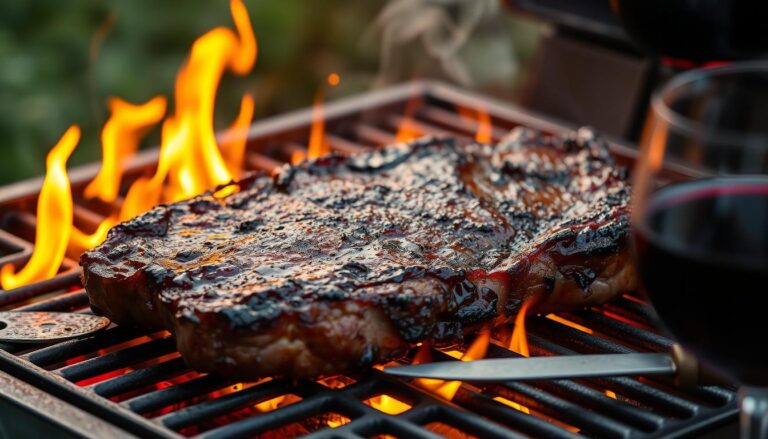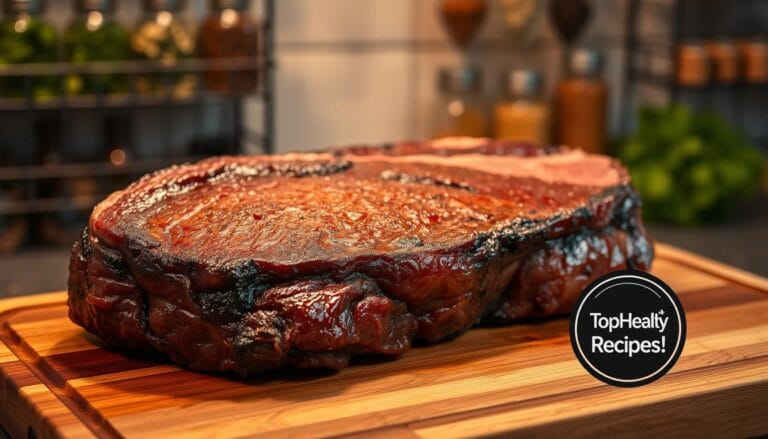What Is Picanha? Discover the Juicy Brazilian Beef Everyone Loves
Table of Contents
What Is Picanha? Discover the Juicy Brazilian Beef Everyone Loves
You might have heard of picanha beef cut, a favorite from Brazil loved by food lovers everywhere. This cut comes from the top of the rump cap. It’s famous for its distinctive fat cap, which makes it juicy, tender and rich in flavor.
Picanha is the star of Brazilian barbecue and is now making its way into American kitchens. Its special features make it a hit in any dish. As you learn more about picanha, you’ll see why chefs and foodies adore it.
Key Takeaways
- Picanha is a triangular cut from the top of the rump cap, known for its distinctive fat cap.
- The fat cap contributes to the cut’s juicy, tender texture and rich flavor.
- Picanha is considered the crown jewel of Brazilian barbecue.
- It’s gaining popularity in American kitchens due to its unique characteristics.
- Picanha is a versatile cut, suitable for various culinary settings.
The Origin of Picanha: A Brazilian Tradition
Picanha is more than a cut of beef; it’s a tradition in Brazilian barbecue. It has been a key part of Brazilian food for decades. Its roots are in the country’s gaucho culture.
Brief History of Picanha
The word “picanha” comes from the Portuguese for “rump” or “hindquarters.” This cut was always seen as top-notch in Brazilian food. It’s tender and full of flavor.
Picanha became a big deal in Brazilian barbecue, or churrasco. It’s often the main attraction.
So, why is picanha so important in Brazilian culture? It’s because of the country’s history and the influence of European immigrants. People from Portugal and Italy brought their grilling ways with them.
Regional Variations Across Brazil
Brazil is big and has many different foods. Picanha is no different. In the south, like with the gaucho communities, it’s grilled over an open flame. It’s served simple to keep its natural taste.
In the northeast, picanha gets a local twist. It’s seasoned with spices and marinades that show the area’s African and indigenous roots. This variety makes picanha special in Brazil.
Cultural Significance in Brazilian BBQ
Picanha is more than a favorite beef cut in Brazil. It’s at the heart of social events and celebrations. At churrasco gatherings, picanha is grilled on big skewers. It’s served with rice, beans, and farofa.
Sharing a meal around the grill is a big part of Brazilian culture. It brings people together, creating a sense of community and friendship.
Exploring picanha shows its importance goes beyond just eating. It connects us to Brazilian heritage and the joy of sharing meals. Whether you’re new to picanha or love it, knowing its cultural background makes it even more special.
What Does Picanha Taste Like?
Picanha has a unique taste with a strong beef flavor. It also has a fat cap that melts during cooking, making it tender and juicy. When you eat well-cooked picanha, you get a burst of rich, beefy flavor. Then, a subtle finish leaves you craving more.
Flavor Profile of Picanha
The taste of picanha is complex and rich. It has a robust beef flavor that’s both intense and satisfying. The fat cap, a key feature of picanha, is important for its taste. As it melts during cooking, it adds a juicy, tender texture and a buttery finish, making the taste even better.
How Marbling Affects Taste
Marbling, or the fat in the meat, changes how picanha tastes and feels. Unlike other cuts like ribeye, picanha’s fat is spread out evenly. This makes it tender and juicy. Each bite is full of flavor, with the fat melting in your mouth for a rich, savory taste.
Cooking Techniques That Enhance Flavor
Cooking picanha the right way can make its flavors even better. Grilling it adds a smoky char that goes well with its beefy taste. Roasting it brings out more flavor. The important thing is to cook it so the fat cap melts right, balancing flavor and texture perfectly.
How to Cook Picanha Perfectly
Cooking picanha to perfection takes more than just throwing it on the grill. It requires technique and patience. You need to know the different cooking methods and how they affect the final result.
Grilling vs. Roasting: What to Choose
Grilling and roasting are two popular ways to cook picanha. Grilling is a traditional Brazilian method, often used in churrasco. It gives a smoky flavor and a nice char on the outside, while keeping the inside juicy.
Roasting is a more controlled method that can result in a consistently cooked piece of meat. It’s great for larger cuts of picanha. Your choice between grilling and roasting depends on your equipment, desired outcome, and experience level.
Seasoning Your Picanha: Tips and Tricks
Seasoning is a key step in preparing picanha. Brazilians often use coarse salt, but you can try different rubs and marinades. The goal is to enhance the natural flavor without overpowering it.
- Use a mixture of salt, pepper, and garlic for a classic flavor.
- Experiment with herbs like thyme and rosemary for a more aromatic taste.
- For a spicy kick, consider adding chili flakes or paprika to your rub.
Recommended Cooking Times and Temperatures
Cooking picanha to the right temperature is key for the perfect doneness. Most cuts should be cooked to medium-rare to medium. This balances tenderness with flavor.
| Level of Doneness | Internal Temperature (°F) | Cooking Time (minutes) |
|---|---|---|
| Rare | 130-135 | 10-12 |
| Medium Rare | 135-140 | 12-15 |
| Medium | 140-145 | 15-18 |
Using a meat thermometer is highly recommended to ensure accuracy. Also, let the picanha rest for a few minutes before slicing. This allows the juices to redistribute.
The Best Cuts of Picanha
Picanha is a key part of Brazilian food. Choosing the right cut is key to enjoying its taste. Knowing what to look for at the butcher or store can enhance your meal.
Understanding the Different Cuts
Picanha comes from the rump cap of the cow. It’s known for its triangular shape and rich flavor. You can find it as whole roasts or pre-cut steaks.
The fat cap on picanha is important. It adds flavor and tenderness. When picking picanha, remember the fat cap is part of the cut, not just fat.
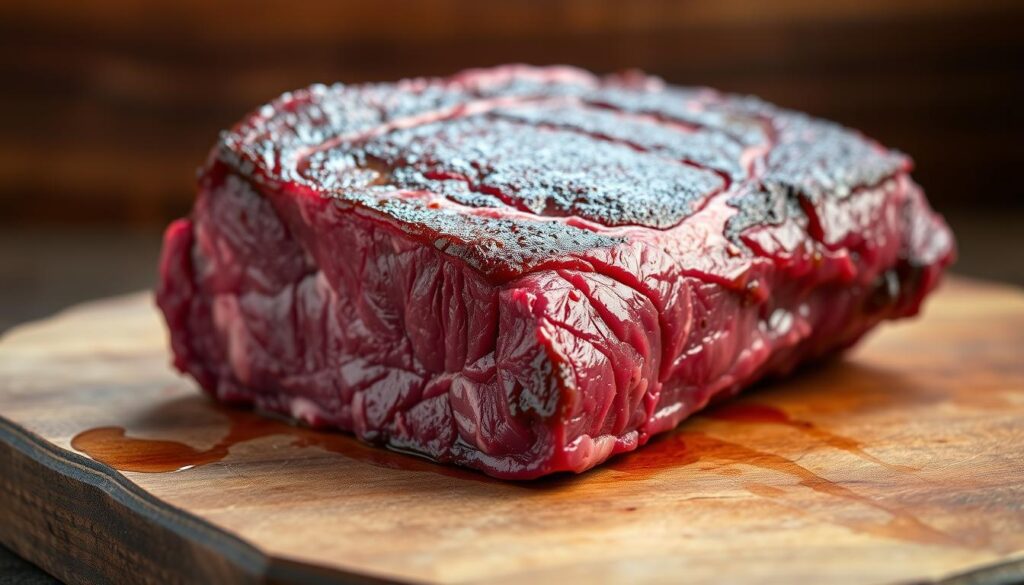
How to Select Quality Picanha
Choosing good picanha involves looking at the fat cap and the meat. Here are important things to check:
- Fat Cap Thickness and Color: A good picanha has a thick, creamy-white fat cap. This shows it’s fresh and well-handled.
- Meat Color and Marbling: The meat should be deep red with even marbling. This marbling makes the meat tender and flavorful.
- Texture: The meat should feel firm, and the fat cap should be smooth.
| Characteristics | High-Quality Picanha | Lower-Quality Picanha |
|---|---|---|
| Fat Cap | Thick, creamy-white | Thin, yellowish |
| Meat Color | Deep red | Pale or uneven color |
| Marbling | Evenly distributed | Little to no marbling |
Common Mistakes When Buying Picanha
Even meat experts can make mistakes with picanha. Here are common errors to avoid:
- Mislabeling: Make sure it’s really picanha and not mislabeled.
- Incorrect Fat Content: Steer clear of picanha with too little or too much fat. It affects flavor and tenderness.
- Improper Trimming: Check that the picanha is trimmed right. Too much trimming can make the meat less flavorful.
Knowing these common mistakes helps you pick high-quality picanha for your next meal.
Picanha in Brazilian Cuisine
Picanha is a key part of Brazilian food, loved for its rich taste and soft texture. It’s found in many traditional dishes, highlighting its delicious flavor and tender feel.
Traditional Dishes Featuring Picanha
In Brazilian cooking, picanha shines in several famous dishes. Picanha na tábua is one, where it’s served on a wooden board with rice, beans, and farofa. Another favorite is picanha no alho, which adds garlic for extra taste. At rodízio-style restaurants, picanha is a main attraction, offered in a never-ending flow of grilled meats.
Picanha as a Staple in Churrasco
Churrasco, Brazil’s barbecue, can’t be complete without picanha. It’s the star of any churrasco, grilled to perfection over an open flame. Sliced thinly against the grain, each piece is tender and full of flavor. Grilled veggies, salads, and bread are common sides, making the meal even more special.
Churrasco is more than just food; it’s a way to connect with others. It brings people together, creating a sense of community and joy.
Modern Twists on Classic Recipes
Today, Brazilian chefs are getting creative with picanha, adding new twists to old favorites. They’re mixing traditional flavors with international ones and making picanha even more special. These new ideas might inspire you to try something different at home, like using different marinades or cooking methods.
Some chefs are even using picanha in unexpected ways, like in salads or on pizzas. This shows how versatile picanha can be, beyond just grilling.
Pairing Wine and Picanha
Enjoying picanha steaks is even better with the right wine. Picanha’s rich flavor and tender texture need a wine that matches well.
Best Red Wines to Enhance Your Meal
Red wines are best for picanha because they have strong flavors. Here are some great choices:
- Malbec: Its plum and blackberry tastes go well with picanha’s char and savory flavors.
- Cabernet Sauvignon: This wine’s tannins and dark fruit flavors match picanha’s bold taste.
- Brazilian Reds: Wines like Touriga Nacional or Syrah/Shiraz from Brazil are a perfect match, reflecting picanha’s cultural roots.
These wines balance picanha’s fattiness with their acidity and tannins, making the meal better.
Recommendations for Side Dishes
Choosing the right side dishes can make your meal even better. Traditional Brazilian sides include:
- Farofa: Toasted cassava flour adds a nice crunch.
- Vinagrete: A tangy vinaigrette made with tomatoes, onions, and peppers, contrasting nicely with the meat.
- Pão de queijo: Cheese bread is a great match for picanha’s savory flavors.
- Grilled vegetables: They offer a lighter contrast to the meat’s richness.
Considerations for Flavor Compatibility
When pairing picanha with wine and side dishes, think about flavor compatibility. Balance is key. You want a harmony between the main dish, wine, and sides. Consider:
- Acidity: A wine with good acidity can cut through picanha’s richness.
- Texture Contrast: Mixing textures, like tender meat, crunchy farofa, and soft cheese bread, adds depth.
- Complementary Flavors: Choose sides and wines that complement picanha’s flavors, without overpowering it.
By carefully pairing picanha with wine and side dishes, you can make a memorable meal that highlights Brazilian cuisine.
Health Benefits of Picanha
Picanha is a nutrient-rich food that offers many health benefits. It’s a cut of beef that’s not only tasty but also full of good stuff. The right cooking methods and portion control are key to getting the most out of it.
Nutritional Value of Picanha
Picanha is a great source of protein, which helps muscles repair and grow. It’s also packed with vitamins and minerals like vitamin B12, zinc, and iron. These are important for healthy red blood cells and a strong immune system.
The fat in picanha is high, but it’s got good stuff like conjugated linoleic acid (CLA). This is more common in grass-fed beef.
- High Protein Content: Essential for muscle repair and growth.
- Rich in Vitamins and Minerals: Vitamin B12, zinc, and iron support various bodily functions.
- Presence of CLA: Found in higher amounts in grass-fed beef, CLA has been linked to several health benefits.
Lean Cuts and Healthier Options
To make picanha healthier, trim some fat before cooking. This reduces the fat content, making it leaner. Grass-fed picanha is better because it has more omega-3 fatty acids and CLA.
Choosing how you cook picanha is also important. Grilling or roasting is better than frying. These methods let the fat drip away, lowering fat intake.
Balancing Picanha with a Healthy Diet
To enjoy picanha healthily, watch your portion sizes and how often you eat it. Aim for a 3-ounce serving. Pair it with veggies and whole grains for a balanced meal.
“The key to enjoying picanha while maintaining a healthy diet is moderation and balance. Pair it with plenty of vegetables and whole grains.”
By being smart about how you prepare and eat picanha, you can enjoy its flavor and nutritional benefits.
Picanha and the American Grill Scene
Picanha, the star of Brazilian barbecue, is now popular in the U.S. grill scene. More Americans are trying picanha for its rich flavors and tender texture. It’s becoming a favorite for backyard barbecues.
Rising Popularity in the U.S.
Picanha’s unique taste and growing interest in international food are why it’s popular in the U.S. Food lovers seek new flavors, and picanha is perfect for that.
A recent survey shows a big rise in demand for specialty meats like picanha. People want to try new recipes and cooking methods.
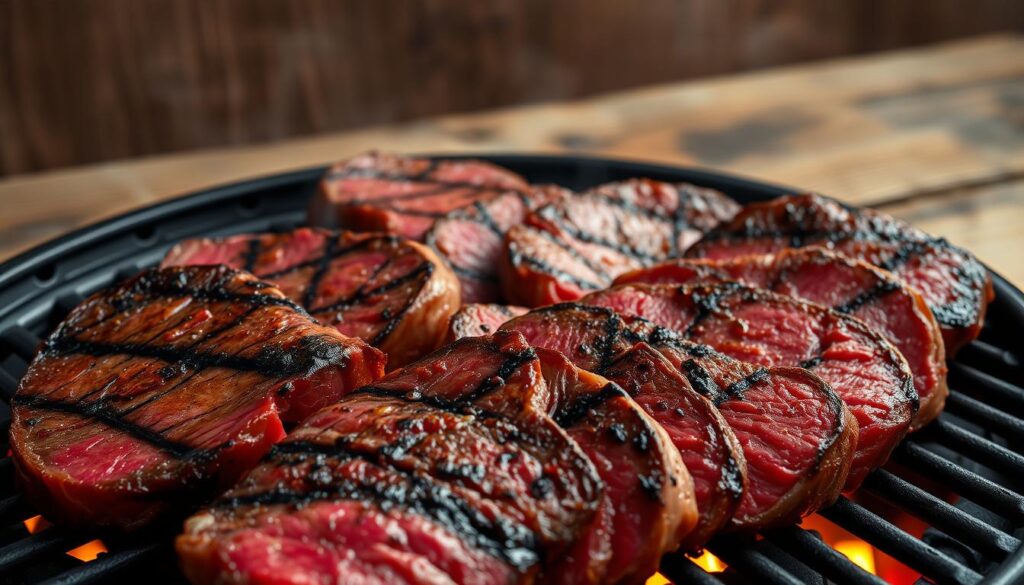
Finding Picanha at Local Butchers
Finding picanha can be tricky, but it’s worth it. Here’s how to find it at local butchers:
- Use the right terms: Ask for “rump cap” or “coulotte” as these are common names for picanha.
- Visit specialty butcher shops: They are more likely to carry or order picanha for you.
- Check online meat suppliers: Many online retailers now offer picanha, and it can be delivered to your doorstep.
Tips for Hosting a Picanha BBQ
Hosting a picanha BBQ is a fun way to entertain guests. Here are some tips to make it a success:
- Plan your menu: Picanha is the main attraction, but add traditional Brazilian sides like rice, beans, and farofa.
- Invest in the right equipment: A grill or churrasco setup is best for cooking picanha perfectly.
- Educate your guests: Share the rich flavors and cultural significance of picanha.
| Equipment | Purpose |
|---|---|
| Grill or Churrasco Setup | Cooking Picanha |
| Meat Thermometer | Ensuring Perfect Doneness |
| Tongs and Forks | Handling and Serving |
“Picanha is more than just a cut of meat; it’s an experience. When cooked correctly, it brings people together and creates unforgettable memories.” – Renowned Chef
By following these tips and understanding picanha’s cultural significance, you can host a memorable BBQ. Your guests will love it.
FAQs About Picanha
Exploring picanha can raise many questions. Whether you’re a pro chef or new to picanha, knowing the basics can make cooking more fun.
What Is the Best Way to Store Picanha?
Keeping picanha fresh is key. Store it in the fridge at 40°F (4°C) or lower. Wrap it tightly in plastic or foil for a few days.
For longer storage, freeze it. Use airtight packaging or freezer bags to prevent freezer burn. Frozen picanha can last months.
Thaw frozen picanha in the fridge or under cold water. Don’t thaw at room temperature to avoid bacterial growth. Cook it within a day or two for the best taste and texture.
Can I Substitute Picanha with Other Cuts?
Yes, you can use tri-tip or top sirloin cap as substitutes. They offer similar flavor and tenderness. But, remember, picanha’s fat cap makes it special, so cooking methods might need adjusting.
Choose cuts with good marbling for juiciness and flavor. Adjust seasoning and cooking to match the substitute’s characteristics.
How Is Picanha Pronounced?
Picanha is pronounced “pee-KAH-nyah.” Knowing this can help you order or talk about picanha with confidence. It shows respect for the cuisine and helps in communication with chefs or butchers.
Additional FAQs
People often ask about picanha’s price, serving sizes, and fat cap removal. Picanha costs like other premium beef cuts. Serving sizes vary by appetite. The fat cap is usually left on to keep the meat moist and flavorful.
Troubleshooting Common Picanha Cooking Issues
Getting the perfect picanha dish can be tricky. But, knowing how to fix common mistakes can help. Whether you’re a pro or just starting, learning to solve these problems can make your picanha better.
Dry vs. Juicy Picanha: What Went Wrong?
Getting picanha just right can be hard. It might turn out dry because of overcooking, bad fat cap handling, poor resting, or wrong slicing.
- Overcooking: Use a meat thermometer to ensure the internal temperature reaches 130°F – 135°F for medium-rare.
- Improper Fat Cap Management: Score the fat cap in a diamond pattern to help it render evenly during cooking.
- Poor Resting Techniques: Let the picanha rest for 10-15 minutes before slicing to allow juices to redistribute.
- Incorrect Slicing: Slice against the grain to ensure tenderness.
Over-seasoning: How to Fix It
Too much salt or spices can ruin the taste of picanha. To fix it, try balancing the flavors or adjust the seasoning next time.
| Issue | Solution |
|---|---|
| Too Salty | Add a dairy product like sour cream or yogurt to balance the saltiness. |
| Too Spicy | Serve with a side of rice, bread, or a dairy product to neutralize the heat. |
Ensuring Even Cooking for Perfect Results
Even cooking can be tough. It’s because of uneven cuts, hot spots on grills, and oven temperature issues.
- Strategic Placement: Place thicker parts of the picanha towards the heat source.
- Rotation: Rotate the picanha regularly to ensure even cooking.
- Two-Zone Cooking: Use a two-zone cooking method to sear and then finish cooking at a lower temperature.
By tackling these common problems, you can get better at cooking picanha. And you’ll enjoy a perfectly cooked dish every time.
Conclusion: Why You Should Try Picanha
Now that you know about picanha, it’s time to try it. This Brazilian beef is loved for its tender meat and fat cap. It’s a key part of Brazilian BBQ.
Discovering the Flavors of Picanha
Picanha’s taste comes from its marbling and cooking. Learning to cook it in the oven is a good start. This method ensures even cooking and enhances the meat’s flavors.
Exploring Picanha Recipes
As you learn more about picanha, try different recipes. It works well in both traditional Brazilian dishes and modern recipes. Pair it with your favorite sides and wines for a memorable meal.
Joining the Picanha Community
Trying picanha means joining a lively food community. Look for online forums, attend local events, and share your picanha adventures. This way, you’ll keep learning and enjoying picanha.
FAQ
What is picanha?
How do you pronounce picanha?
Can I substitute picanha with other cuts of beef?
How should I store picanha?
What is the best way to cook picanha?
How do I cook picanha in the oven?
What are picanha steaks?
How do I know if my picanha is cooked to the right doneness?
Can I cook picanha without the fat cap?
What are some traditional Brazilian ways to prepare picanha?
Are there any health considerations when consuming picanha?
For more cooking tips, stay connected with us. We also recommend the cookbook Skinnytaste Simple: Easy, Healthy Recipes with 7 Ingredients or Fewer
For more Recipes about Steak ?
Did You try our recipe ?
There are no reviews yet. Be the first one to write one.
